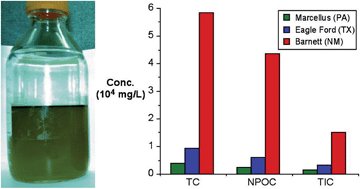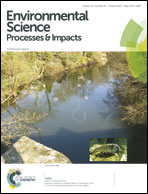Organic compounds in produced waters from shale gas wells†
Abstract
A detailed analysis is reported of the organic composition of produced water samples from typical shale gas wells in the Marcellus (PA), Eagle Ford (TX), and Barnett (NM) formations. The quality of shale gas produced (and frac flowback) waters is a current environmental concern and disposal problem for producers. Re-use of produced water for hydraulic fracturing is being encouraged; however, knowledge of the organic impurities is important in determining the method of treatment. The metal content was determined by inductively coupled plasma optical emission spectrometry (ICP-OES). Mineral elements are expected depending on the reservoir geology and salts used in hydraulic fracturing; however, significant levels of other transition metals and heavier main group elements are observed. The presence of scaling elements (Ca and Ba) is related to the pH of the water rather than total dissolved solids (TDS). Using gas chromatography mass spectrometry (GC/MS) analysis of the chloroform extracts of the produced water samples, a plethora of organic compounds were identified. In each water sample, the majority of organics are saturated (aliphatic), and only a small fraction comes under aromatic, resin, and asphaltene categories. Unlike coalbed methane produced water it appears that shale oil/gas produced water does not contain significant quantities of polyaromatic hydrocarbons reducing the potential health hazard. Marcellus and Barnett produced waters contain predominantly C6–C16 hydrocarbons, while the Eagle Ford produced water shows the highest concentration in the C17–C30 range. The structures of the saturated hydrocarbons identified generally follows the trend of linear > branched > cyclic. Heterocyclic compounds are identified with the largest fraction being fatty alcohols, esters, and ethers. However, the presence of various fatty acid phthalate esters in the Barnett and Marcellus produced waters can be related to their use in drilling fluids and breaker additives rather than their presence in connate fluids. Halogen containing compounds are found in each of the water samples, and although the fluorocarbon compounds identified are used as tracers, the presence of chlorocarbons and organobromides formed as a consequence of using chlorine containing oxidants (to remove bacteria from source water), suggests that industry should concentrate on non-chemical treatments of frac and produced waters.


 Please wait while we load your content...
Please wait while we load your content...